
Finding Connection to Place though Indigenous Knowledge with Garden Futurist Judy BlueHorse Skelton
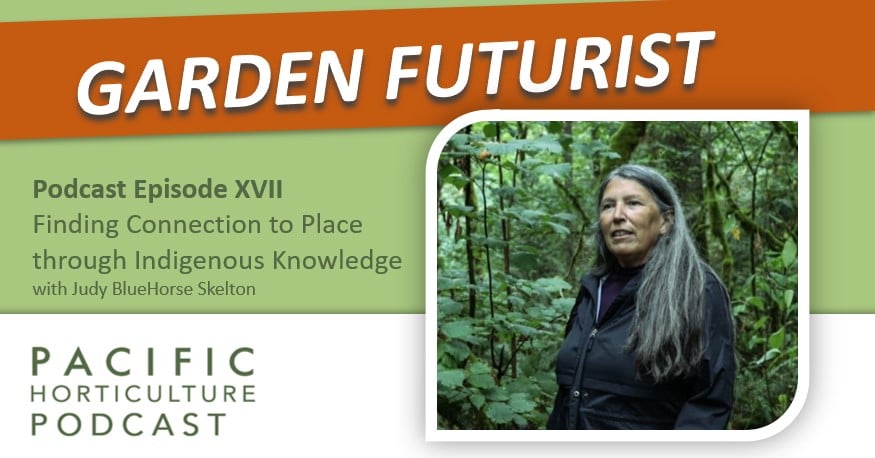
Contributor
- Topics: Nature is Good For You
Summer 2022
Listen to full Garden Futurist: Episode XVII podcast here.
When we look at the Willamette Valley, we recognize that we see these remnant giants of Oregon white oak in the landscape. Those Oregon white oaks and the oak savanna have been historically managed with cultural burns since time immemorial. If we can look at the oak savanna—of which about 3 percent remains today, it’s an endangered ecosystem, just like the redwoods or old growth forests—we can see that a lot of our native plant relatives like nettles (Urtica) and the prairies of camas (Camassia) that we are in the process of replanting.
Judy BlueHorse Skelton is an Assistant Professor in Indigenous Nations Studies at Portland State University.
This interview has been edited to reflect the audio version on #Garden Futurist.
Sarah Beck: You are listening to Garden Futurist. I’m Sarah Beck, here with Adrienne St. Clair. Hi, Adrienne.
Adrienne St. Clair: Hi, Sarah.
Sarah Beck: Adrienne, there has been a theme that has been running through a number of our podcasts this year, and the oak savanna ecosystem is really a part of that conversation. It makes sense, because a large geographic area within the Pacific region is really touched by this ecosystem.
We’ve had this conversation a few different ways, but we haven’t had a first-person perspective—until now—that shares the Indigenous traditional ecological and cultural knowledge side of this story. I think it’s really about time that we have this conversation.
Adrienne St. Clair: Yeah, so we’re hearing from Judy BlueHorse Skelton and you’ll hear her use the phrase ITEK to represent that idea of Indigenous traditional ecological and cultural knowledge.
Judy’s a professor at Portland State University. Just to give some background on Portland State University, PSU is a blended community. It’s mostly a commuter college, so people live and work regionally and go to Portland State University and usually stay in the region when they’re done with school there.
There’s also a large Indigenous community within the Portland metropolitan area. Portland has something like the ninth largest Indigenous urban population. So they have connections to tribes all across the country. And then Portland State also, interestingly, has this huge international studies program, where students from the rest of the world are coming in to learn.
Sarah Beck: I was really surprised to hear Judy talking about all of these different community members who are coming to this conversation about the oak savanna project that is on the PSU campus and how so many different people from different backgrounds and cultural experiences were really interested in how they could experience this connection to place. In so many ways, Judy shares a roadmap to how to do this. How to, as an individual, find that connection to place.
Adrienne St. Clair: Judy BlueHorse Skelton is a senior instructor and full-time faculty in Indigenous Nations Studies at Portland State University. She’s worked with federal and state Indian education programs throughout the Northwest to create cultural activities focused on traditional and contemporary uses of native plants for food, medicine, ceremony, and healthy lifeways.
Sarah Beck: Judy BlueHorse Skelton, welcome to Garden Futurist.
Judy BlueHorse Skelton: Ta ‘c meeywi, good morning. Good to be here, Sarah.
Sarah Beck: I’m so glad to have you with us. You have had a leading role in the Portland State University oak savanna landscape. And this is a landscape that features Oregon white oak (Quercus garryana) trees and western serviceberry (Amelanchier alnifolia)—and there’s a meadow seed mix. I’m wondering if you could share a bit of the ecological context and history of the oak savanna landscape in western Oregon, just to give us some context.
Judy BlueHorse Skelton: When we look at the Willamette Valley, we recognize that we see these remnant giants of Oregon white oak in the landscape. Those Oregon white oaks and the oak savanna have been historically managed with cultural burns since time immemorial. When Europeans arrived, bringing European-style farming, all of our Indigenous practices of prescribed or cultural burns, our access to digging and gathering, and all of our land practices that ensured we would be provided for from these plant relatives—was disrupted.
The agriculture practices have compacted root structure underneath these giant oaks, which causes them to almost suffocate. And of course the forcing of Indigenous people onto reservations—or here in Oregon, onto small tracks of land. Practices of genocide, removal, termination since contact have all impacted our traditional homelands. in a very traumatic and unhealthy way. But if we can look at the oak savanna—of which about 3 percent remains today, it’s an endangered ecosystem, just like the redwoods or old growth forests—we can see that a lot of our native plant relatives like nettles (Urtica) and the prairies of camas (Camassia) that we are in the process of replanting.
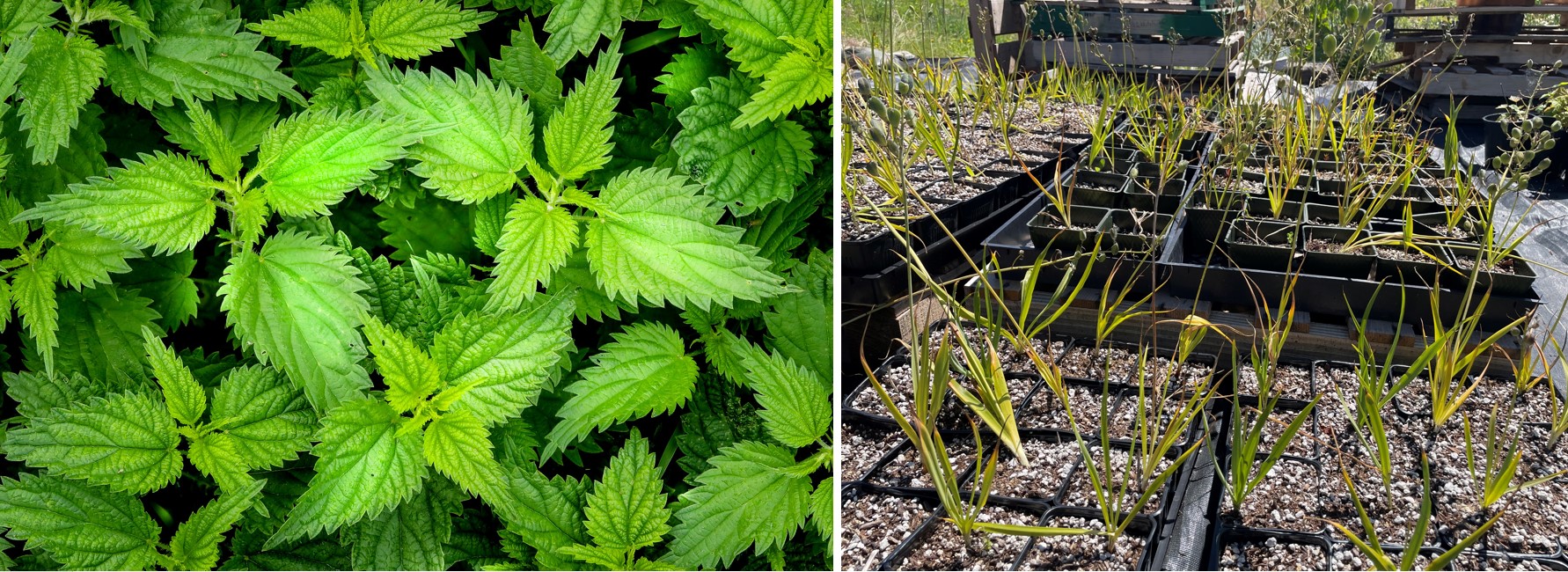
Right: Young Camas (Camassia) at 1855 Plants in Portland, OR. Credit: Sarah Beck
If you can imagine driving down I-5 between the Portland and Vancouver area and heading south all the way to Eugene, you can see those big oaks and you can imagine that open prairie. If we weren’t doing cultural burns, Doug-fir (Pseudotsuga menziesii) likes to come in and they love full sun. And so by burning, you’re keeping out these evergreens that would shade out our traditional foods like camas and so many others.
So we’re looking today at a very disrupted ecosystem. And so the oaks, the white oaks that we have planted over the years, thanks to students’ visionary work. We have a site in the middle of the Portland State University campus, where these oaks were first planted by students about 10 years ago, who were looking to create sanctuary, looking for sacred space in the middle of the campus.
Sarah Beck: I just want to pause for a second, though, to recognize how different these landscapes are that we’re talking about. When you’re talking about the white oak savanna, you’re actually talking about grasslands and you’re talking about an open landscape that is not at all like the Doug-fir dense forest. So I think it’s just really interesting for us to put that in some context, right?
Judy BlueHorse Skelton: Yes.
Sarah Beck: Because that burned, managed landscape is a really different landscape.
Judy BlueHorse Skelton: It really is. It really disrupts the what we call settler narrative, that no one was here.
Sarah Beck: Right, right.
Judy BlueHorse Skelton: And really these open savannas or prairies or grasslands or meadows, they’re highly tended, we call. We would say tending in seasonal rounds, meaning as the seasons move through, we have our seasonal practices that tend and ensure that these systems will continue.
So once you remove folks, once the folks are forced off and another system is brought in, and that system has been very degrading—as we know—across the country in a lot of different diverse ecosystems. A lot of these healthy ecosystems, whether we’re looking at wetlands. We’re here at the confluence of the Willamette and Nch’i-Wàna, the big river, Columbia River. These two rivers, this confluence, very rich in soils and very seasonal in their flooding times, their flooding seasons, and the rich soil they leave behind.
There’s just a rhythm to life. That’s actually part of what the oak savanna on the Portland State University campus is hoping to do is to restore that rhythm. Our physical rhythm and tending, but also our emotional and our spiritual and mental rhythms.
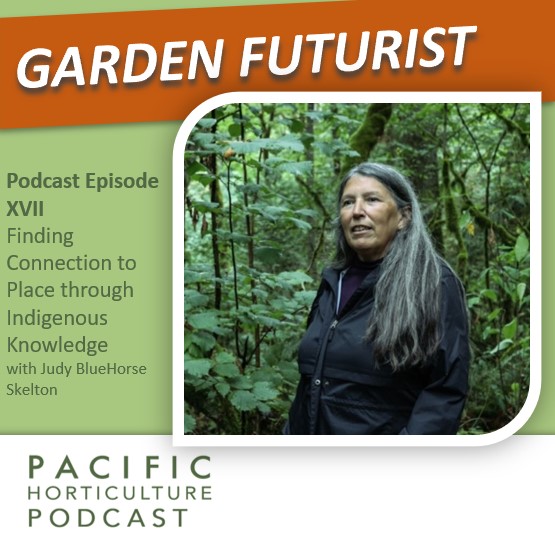
Sarah Beck: Can you talk a little bit about the planning process for this landscape on the campus and what the role of the Indigenous Nations Studies program has been in that?
Judy BlueHorse Skelton: Well, over 10 years ago, through capstones I was teaching on Indigenous gardens and food justice. It’s all about community engagement. It’s about touching the land, being out, what some would call field work, but it was really begun when students started getting onto the land and we had our classes there and through talking circles, doing some of their research: “what was the history, what is the history of this place called Portland today?”
A lot of our Indigenous Nations Studies courses, curriculum, is centered on Indigenous traditional ecological and cultural knowledge (ITEK). While many of my classes were out in the field, we’re on Portland parks land in northeast Portland, at the Native Gathering Garden at Cully Park, which is in the Columbia Slough area, where we have six acres there. We just celebrated our camas tending and harvesting and traditional pit roasting of camas bulbs on Metro land in partnership with them on a place we call Quamash Prairie.
What had to happen first, Sarah, and the kind of invisible work that when folks say, “how are you doing this,” was the relationship building. We’ve been working over 10 years in building the relationships with these agencies that are sitting on our traditional homelands. And I want to be very mindful that we are on the homelands of the many different bands of the Calla Puja and the Clackamas and the Multnomah people. Many of the people who today folks would identify as part of the Confederated Tribes of Grand Ronde and the Confederated Tribes of Siletz Indians. While I am Nez Perce and Cherokee, the urban Indigenous community is a big partner in all the work we’ve been doing for over a decade on these sites.
So now we’re bringing forward this little square within the PSU community and beginning to bring what we’ve learned out in the field into our backyard and on campus where it will be the center of demonstrating, tending, classes, community celebrations, ceremony. We just had a salmon bake last Wednesday as part of our summer gathering event.
Sarah Beck: You’re mentioning the Indigenous students’ voices and you’re also mentioning Indigenous tribal community that is from your exact region. Is there more to understand in terms of the overlap there? Are the students that you are working with also representing that same community or is there some overlap there as well?
Judy BlueHorse Skelton: This is a very inclusive undertaking. What we hear from students and the larger community is this resonates, these Indigenous practices or ITEK often speak to everyone. They recognize that by forming a relationship with land—wherever you’re from. We have students that decide to do our major in Indigenous Nations Studies who are from the Middle East. They’re from Asia, they’re from Africa. We have students from Australia who find a familiar story when we look at colonization, which has been practiced around the world.
In our courses, we look at the story of colonization and its impacts on not just Indigenous communities, but all communities. And so it resonates. What we’ve heard from students is the mode of education, the mode of coming together, learning in a different way, learning through circle methodology, or learning through what some call action-based participatory methodologies.
Sarah Beck: You’ve got to actually be there.
Judy BlueHorse Skelton: You’ve got to be there. That’s right, Sarah. And what we hear is, “Make room,” because everyone wants to be there. Everybody is finding that this this resonates. They will say, “There’s something about this, that this is the way I want to learn. This is the way I want to live. I want to know how to do this. I want to be respectful of this place that I now call home. How do I do this in a good way? How can I learn from the original peoples of this place and honor them and support them and be an advocate?”
And so that’s part of what’s happening and has been happening. The fact that we’re looking at a ITEK center on the site, it’s being guided by principles of humility, generosity, working with the four directions, working with the natural elements, working with the seasons, creating places for storytelling, for Elders to come and visit and perhaps demonstrate.
We are looking at what some of the students call a decolonizing or decolonized library or a hub or a place where all of these things—whether it’s our digging sticks, our cuppins, the way we are making tea, the way we dry the plants, how we do that, where can they be stored? This is a very different way of coming together for that educational experience.
It’s a reciprocal learning experience, really, Sarah. The students aren’t just empty vessels waiting to be filled, but we recognize the students coming and our Elders coming have a reciprocal relationship that we all benefit from when we create the space. We’re creating space for this to happen.
Sarah Beck: It sounds like the model means that whether you’re talking about municipality or agencies that you’re cooperating with, students who are involved, the public interested in this process, it sounds like it is generally a participatory experience?
Judy BlueHorse Skelton: Yes. And it’s the participatory part of this that’s driving it. The participation happened first, and in this coming together, the emerging Indigenous leadership styles and voices—whether it’s Indigenous curricula and related field work—it’s all found a timely synergy with these numerous agencies and community partners, Indigenous and non-Indigenous. Together, we’re all working in a very culturally responsible and responsive way to implement these restorative reclaiming land practices on a landscape that mirrors the same kind of colonizing—it’s more than disruption. In some cases, destruction.
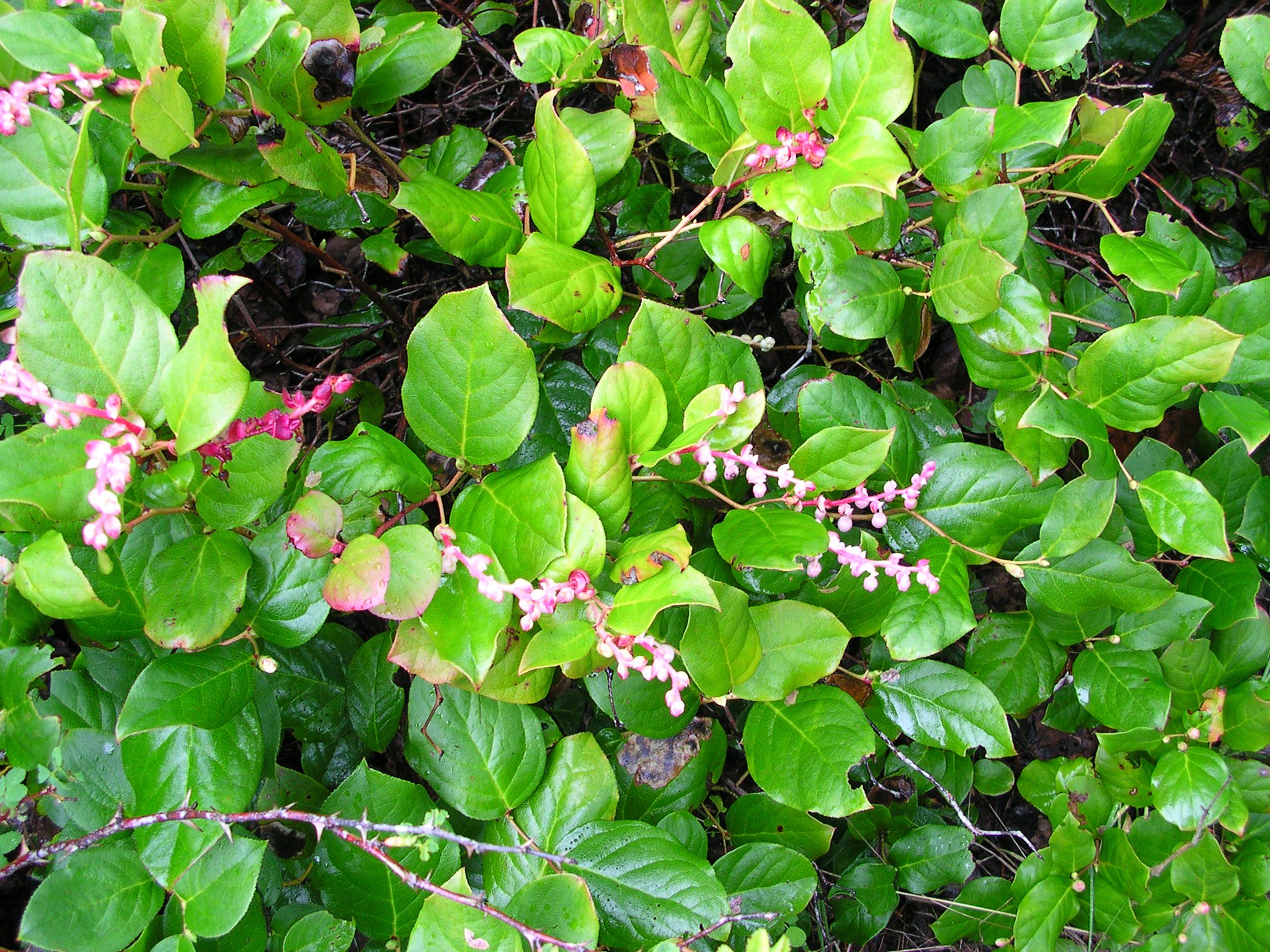
When we look at the Columbia River today, when we look at the Willamette River today, when we look at our coastal communities, when we look at the prairies of the center of what’s called the United States today, these are very disrupted. These are landscapes that are hurting. So that’s happening across the country with Indigenous communities and their partners everywhere.
Part of this is being very driven by wanting to revive and have our healthy first foods, our first medicines. To have healthy first foods like camas, we have to look at what’s the history of agriculture or industry when we get ready to roast and then eat a camas bulb. And so there’s a lot of partnerships needed for cleaning up what has happened in the last—here in the Northwest, in the last 200 years. And so that’s part of this story is how do we collaborate and understand, what is the soil holding?
The wapato, another first foods: little potato, likes to grow in the mud—wetlands area, very vulnerable to heavy metals and other things coming in., when we look at major waterways. Camas also likes wet feet, but can handle a dry summer where we get no rain, because they finish blooming in May. They go back underground and come back again in the next spring.
What we find with those is that if we just stop planting corn, or we stop tilling for potatoes, or all of the other European agricultural practices, these plants have been waiting for us. They come up. We do spend time planting new ones, scattering seeds. But we are finding that they are hiding. They’re there in the land coming back up once we stop the unhealthy practice. And that has been our most uplifting message is that these relatives are just waiting for us to return to the land.
And when we do, when offer those songs, when we are tending with our cuppin instead of a big rototiller or other non-Indigenous tooling, we find they come back.
We’re not doing this work alone. The plants and beaver. What beaver are doing when you stop traditional agricultural farming that was brought over from Europe, the beaver will come back up and they will immediately start making curves in these canals and ditches that were created to accommodate unhealthy farming practices.
We are working with US Fish and Wildlife at the Tualatin River Wildlife Refuge. We were just out there on Saturday, the class, looking at the transformation from an old ditch where there’d been a dairy and farming.
By getting out of the way, of course, listening to beaver is a huge change. It’s a huge shift for Western science and Western land restoration practices to pay attention to what beaver are doing and let them do what they’re doing. They created an incredibly meandering stream, which was once a ditch.
When students finished on Saturday, they said, “There’s a lot to be downhearted, but I just feel so hopeful.” When the eagles fly overhead at these events and at these wetland sites, we feel that we’re not alone. And the hopefulness that comes in for restoring not just our ecosystems or our relatives, but our relationship. That’s what this is really about, Sarah.
WEB EXTRA – Not Included in Podcast Transcript – WEB EXTRA
Sarah Beck: Just as one more question about the oak savanna, is there anything that we missed as far as the story of the plants themselves? We really like to give recommendations of plants that are capable of those natural seasonal changes we see in the West.
Judy BlueHorse Skelton: We have an ITEK Indigenous Nations Studies graduate who’s moved on and created their own consultation for exactly what you’re asking about, Sarah, consulting with Indigenous community and tribal community and working closely with different agencies.
When someone’s restoring a five-acre wetland site, like the project we’re doing with the Bureau of Environmental Services on Shwakuk Wetland, which is the Chinook Wawa word for little frog, which is an indigenous frog to that site. It’s just five acres, but that’s just the right size for community and students. On that site, we develop a very extensive plant list and that’s something we might share more as a resource.
We’re very aware that we want to respect our ancestors’ knowledge about the medicinal aspects of some of our native plants and some of their food aspects. Because we have had in other parts of the country, going back to the ‘80s and ‘90s, where without the protection, folks came in and dug up all of one particular plant on hundreds of acres of prairie land in the Midwest because of the medicine that had been shared.
I share that story because it’s just kind of cautionary. We rely on our Elders to let us know what is appropriate to share, what is too much, what is just right? And how do we share it? Do we share it through going through the experiential that we talked about the very beginning? You are there. You’re participating.
So we have been very mindful about what gets published, what gets lists that are made. However, yes, we do have plants and we’ve worked with others. The Metro has extensive lists of plants based on whether it’s prairie or wetland or foothills or coastal or marshland.
We identify those things that are culturally significant that we might want to see more of. So we’ve added blue elderberry (Sambucus cerulea) to almost every planting we do. It’s one of those that just has so many wonderful uses and it’s so beautiful. It’s a plant that often can grow at the edge of forest, but also can handle prairie and will create more of itself, not a grove necessarily, but if it’s happy where it is then there will be more of them. And that’s part of what we do. We spend a lot of time observing, because the landscape has been changed. We have to see who’s willing to come in and grow there.
And I will add, Sarah, for folks that remember, we had the heat dome here in the Northwest and I was out in the field with Metro scientists doing some other mapping. And we were all just seeing who’s handling this?
How are the alders doing? How are the blue elderberry? Oh, I can say right now the Western redcedars (Thuja plicata) are not handling it well. Doug-fir handled it a little better. This is alarming.
Salal (Gaultheria shallon) and evergreen huckleberry (Vaccinium ovatum), these leathery, evergreen, beautiful plants. They struggled, they were burned. The leaves I’ve been watching elsewhere, my own garden, what their recovery is, I’ve seen that they can recover underground. Also other parts become robust. I saw them this spring with this wet spring. They’re all pushing out a lot of new growth, including blue elderberries. But I think we’re in uncharted waters right now.
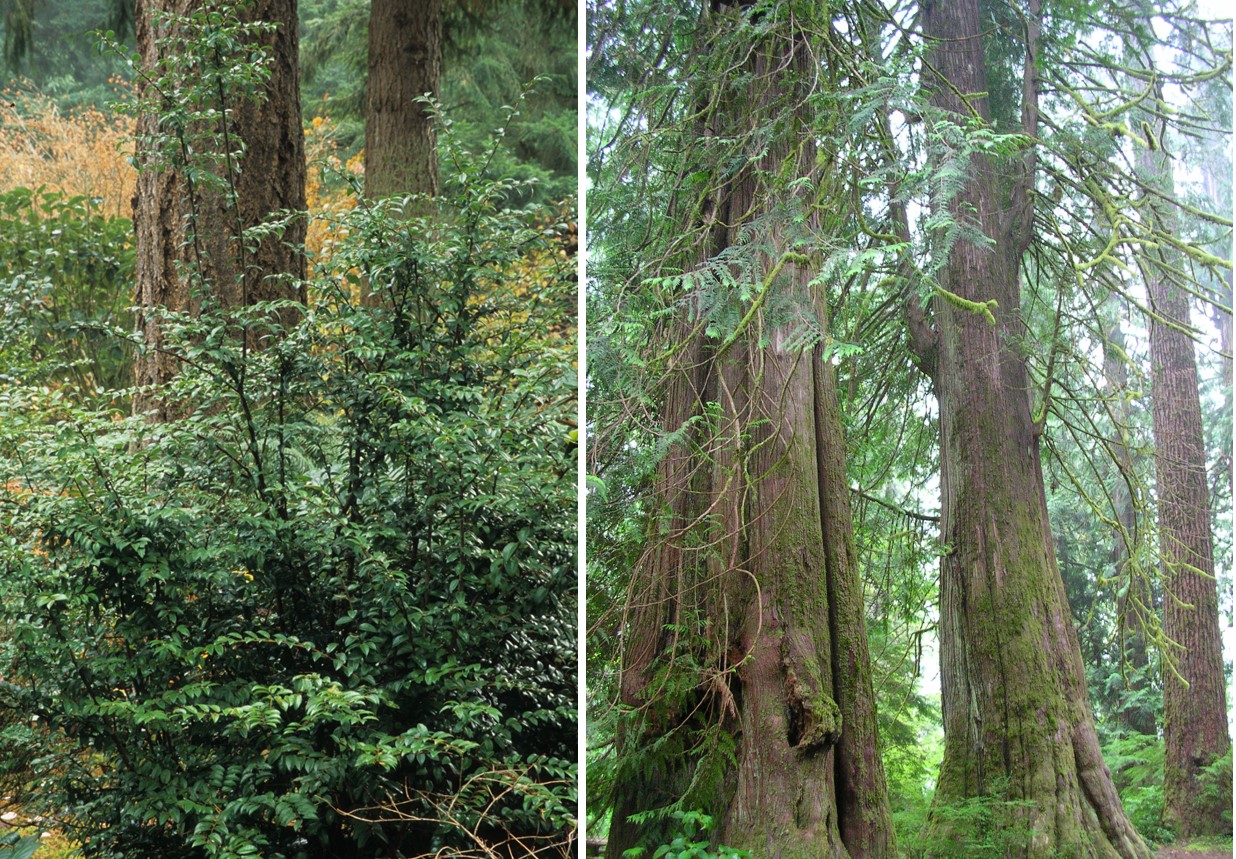
Right: Western Red Cedar (Thuja plicata) near July Creek. Credit: Brew Brooks
Gardeners are often already talking to their plants. They’re intimately involved. They know them through the seasons. They’ve been observing them often for many years, if not decades. They have their favorites. you have folks that will go with the hybridized that’s had a particular rust or something else, hybrid out of it to see how it’s doing. We also have folks that stick to the original, which is harder and harder to find at nurseries, the original native plant. I find Oregon grape (Mahonia aquifolium), for instance, I get alarmed at how much hybridizing. When they hybridize our native plants, they’re not doing that for the medicinal, the chemical constituents, those properties that are in the root or in the leaf. They’re looking at color or they’re looking at an extended bloom time.
So I find that that’s a big challenge to the work we’re doing is finding finding stock.

Right: Oregon Grape (Mahonia aquifolium). Credit: D. Eickhoff
Sarah Beck: The genetic resources.
Judy BlueHorse Skelton: Exactly. And that’s one of the things where we’re really emphasizing to these partners that have their own nurseries, like Metro or the East Multnomah Soil and Water District folks is, “Has this been tweaked, has this been adjusted?” And there are times when a plant has been provided that I can tell from the leaf structure that no, that’s the hybridized one.
So there’s a lot of challenges to restoring traditional lands with our traditional relatives. So that’s another impact we’re having on these agencies and nurseries as well is what’s also Indigenous communities are also sharing. We’re sharing our plants.
We also recognize that through observing camas that are found in this particular prairie may not do as well. If we trade them or give them up to another location 50 miles away. We’re finding a lot of microclimates and we’re trying to respect what the plants are teaching us about where they want to live, where they can be.
I think we still have a lot to learn about these microecosystems or these little communities from pond to pond, stream to stream. There are some unique ways they have adapted to these areas. What can they teach us as we look at a changing climate for their adaptability? We’re just going to have to get outside and be more intimate with these plant relatives. We’re just going to have to get outside. And I think that’s always exciting, to get outside.
Sarah Beck: Absolutely. Do you have any specific advice for gardeners who are really interested in supporting native plants in their region?
Judy BlueHorse Skelton: What gardeners can do is ask nurseries, Portland nurseries, what is your source? The Oregon Nursery Association, I think letting them know to be mindful that we want these resilient Northwest natives that have the gifts that has not been measured, really. The gifts that they provide, whether that’s nutritional composition of a camas bulb, whether that’s the nutritional value of the blue elderberries, those have been hybridized a bit so the berries taste sweeter. I don’t know who’s doing the research, if they still have their medicinal qualities, I’m sure they probably do because so much of their medicine is in that rich skin. I think growing native plants, I think observing.
This fall, we have a new certificate. It’s called our ITEK certificate and it will be a one-year certificate that focuses on all of our courses where we really practice. We learn. We get out in the field. We love internships or fellowships, we’re looking for the right word for that reciprocal relationship. This is an opportunity for some of our partners to also take this certificate and become more familiar.
But what I wanted to share is what we’re looking to create is sort of where you can post your picture of how the plant’s doing after a heat dome. And we can have a conversation. Students have said, “Let’s create a website where we can start with some people, call it citizen science or layperson science, where we can start having the conversation about, ‘Well, I’m over here in Southeast Portland, along the Johnson Creek. And I found these are we’re able to survive under an understory of alder (Alnus).’”
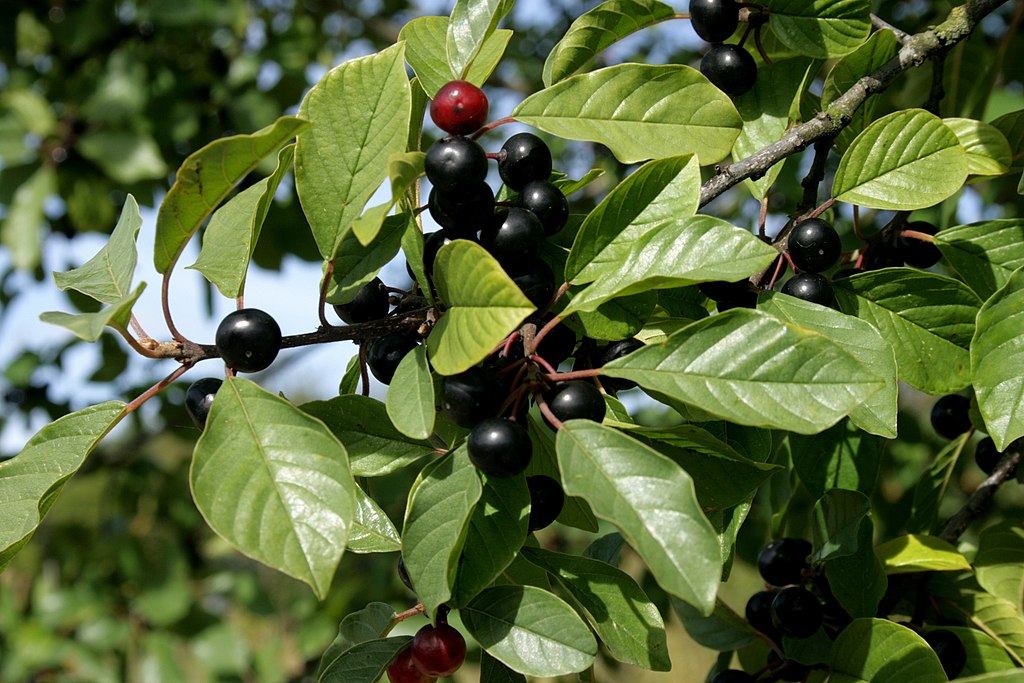
And I think those are the conversations that we’re going to start having. The students are so excited. I love this. And part of it is in the face of the heat dome, in the face of a climate that is changing rapidly and has a huge impact on our younger generations. It has an impact on all of us, but they’re wondering, “How do we live here in a good way?”
And so these are ways that help empower them to be part of telling that story, and be part of a conversation, and to be monitoring or developing the relationship that says, “I’m over here. And here’s how here’s how nettles are doing,” or “the nettles were three weeks late this year,” or “they’re flowering early.”
It’s very local. It’s very local, but I think that’s what we’re looking at. We’re going to be looking at how to strengthen microclimates, how to create these micro-ecosystems that, as humans, we can tend and we can be watching and we can belong.
It’s really about belonging. That’s it.
Sarah Beck: I love the optimism in the ability to participate, even if it is an observation that is perhaps a plant is not performing perfectly, or it’s not surviving as well as it might. It does sound to me like what you’re hearing is people participating in that conversation helps them feel hopeful.
Judy BlueHorse Skelton: Hopeful is the word. I don’t know about optimistic, Sarah, but what we realize is for our Indigenous folks who have survived the history of this land and the history of policy, we find hope because we’re still here.
So doesn’t look like it did 500 years ago or 250 years ago, but I think what we have to remember is the gift of our ancestors, whether it’s our plant ancestors or just the intrinsic ancestor that dwells within the land and the water. It was always about change, but we’re part of that and we want to be part of that. It’s why we’re still here.
It’s also an understanding that change is just part of the journey. So I feel the students and the community and the land is saying, “Well, let’s all work together. We always have.” People forgot. So part of this is remembering our original instructions and in that remembering, we recognize that we do belong here. We’re just going to have to be very responsible, very respectful, and work together.
Sarah Beck: You have brought another component that I don’t know if we’ve put enough attention to, which is the community participation part. And this isn’t just about doing something in isolation. I love that you brought that piece of this conversation to us today.
Judy BlueHorse Skelton: Yes. We were just out at the wildlife refuge Saturday, and I saw so many kids planting native plants along the edge of this new meandering creek that the beavers have helped create. So volunteering on these larger sites that are in the process of what I call recovery from discovery—the doctrine of discovery and being planted.
Volunteer. Volunteer with these agencies that are busy trying to get red osier dogwood (Cornus sericea) back, willow (Salix), other streamside riparian edge plants. Portland parks has planted thousands and thousands, with Indigenous community and our classes and students they’ve planted thousands of camas bulbs down at the Oaks Bottom Wildlife Refuge on the Willamette River.
So get out and advocate and get your hands dirty and just know that these agencies do coordinate a lot of community plantings, and many hands, as they say, can help recover a camas prairie pretty fast.
Sarah Beck: You might actually have some fun out there, too.
Judy BlueHorse Skelton: Oh, yes. Students have said it’s the highlight.
And the children, you get little people out there. They love it. So does everyone of all ages, but it’s a great opportunity for children to connect with where they live and connect with the earth and not be afraid of the unknown. It becomes a lifetime of being for them. They’re committed, they feel connected and they’re going to protect, and that’s what we need. We need people to be aware, to respect and protect.
Sarah Beck: In my conversation with Judy, we went back and forth between the term optimism and the term hope. I’m starting to see a really definite distinction between these terms. While we really want to be optimistic about the future, we also—in seeing the impacts of climate change, in seeing biodiversity loss and cultural loss—we also recognize that this is happening. There is a difference between recognizing that we’re looking at a tiny percentage of an ecosystem that still exists and working on that and that hopefulness is the working on it.
Adrienne St. Clair: Yeah, I thought that was a really interesting distinction to make and place to be coming from as well. I think it ties into this idea that no matter what has happened in the past, we are all moving forward and have to choose how we move forward within the space that we’re in.
That idea of hope, I think of hope as requiring an action, as opposed to optimism, which is just a state of mind. I think of hope as needing this engagement as part of the community. To be able to hear how Judy’s able to connect and engage community is something that I think inspires me to not only do the work that I’m doing for myself and for the environment, but to connect to other people in order to do the work, which I sometimes forget about.
Sarah Beck: And that, from her stories, was the joyful part. When she talked about students and volunteers whose favorite part of the course or project was to be in that setting, going out in the field and doing something, I love that you’re giving that component of hope as an action. I think that’s absolutely right, that being optimistic is something you can do sitting alone. But hope is something that can come from acting together.
Judy also mentioned the fact that gardeners are already talking to their plants.
Adrienne St. Clair: Yeah, that connection to place is something that comes naturally to gardeners because they’re working with these same plants for seasons and years if not decades. That idea that gardeners have that connection to place inherently is an excellent place to start from for everyone out there.
Resources
Judy BlueHorse Skelton recommends Bosky Dell Natives in West Linn, Oregon, for sourcing native plants.
See the Confederated Tribes of Grande Ronde Silviculture and Fire Protection page for more information on forest health using Indigenous traditional ecological and cultural knowledge.
Eldridge, Cory. 2020. Restoring fire: prescribed burn at Quamash Prairie reconnects land, culture and habitat. Metro News. January 2, 2020.
Travel Portland. 2022. Indigenous Foods Resurface in Portland. July 25, 2022.
Share:
Social Media
Garden Futurist Podcast
Most Popular
Videos
Topics
Related Posts
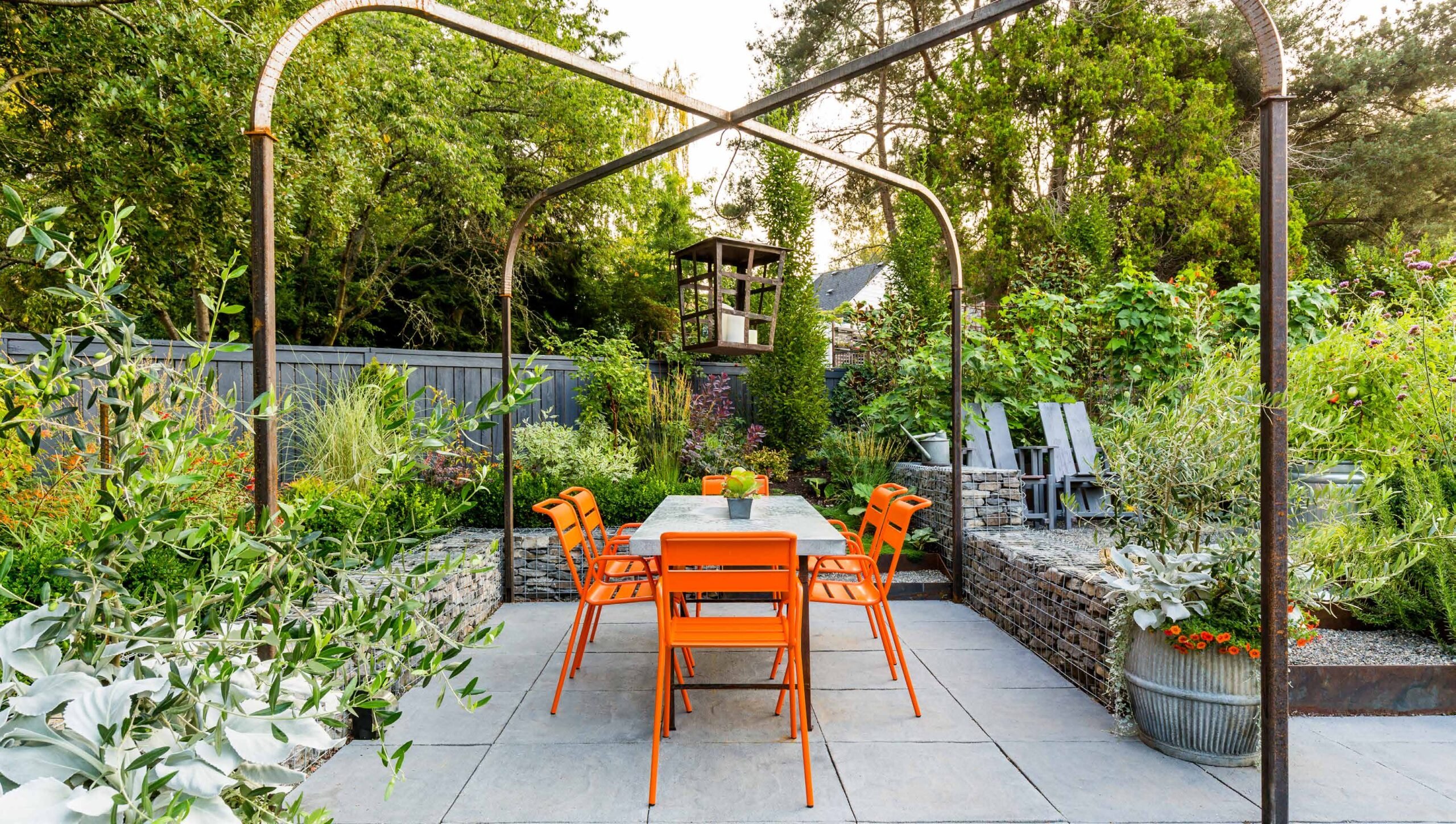
Design Futurist Award Announced: Committee Shares Vision
March 8, 2023 At Pacific Horticulture, we believe that beauty can be defined not only by gorgeous plants and design, but also by how gardens
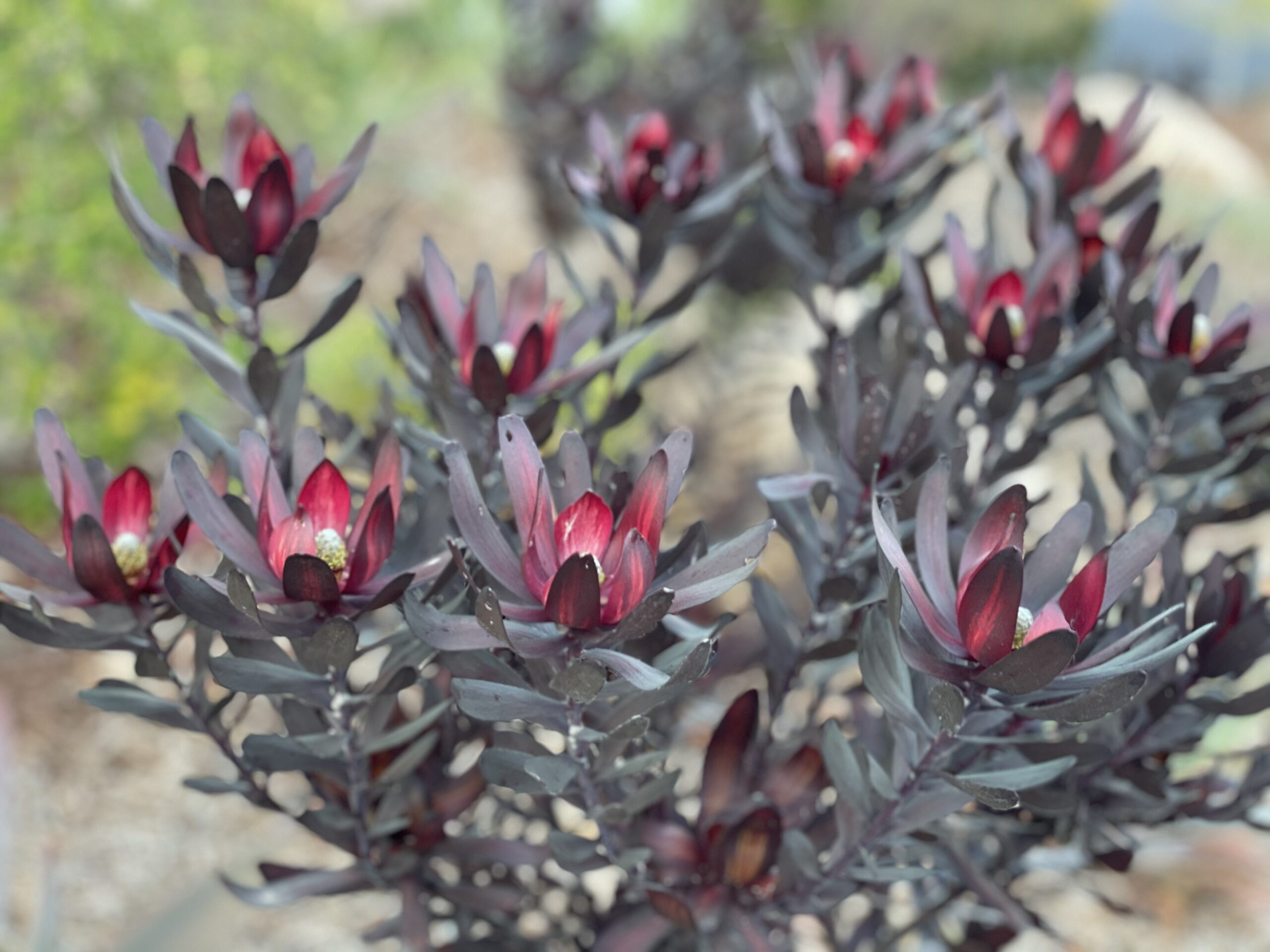
Expand Your Palette: Waterwise Plants for your Landscape
There’s nothing more thrilling to plant lovers than discovering new plants to test in the garden. Here in the southernmost corner of California, we have

What Climate is This? Part Two – A Garden Futurist Special
Winter 2022 Listen to the Part 2 Podcast here. If you live in the Pacific region, you know that seasons in your garden look different

Nature Therapy from the Contemplative Garden
Winter 2022 Women’s hushed morning voices mingled with crashing waves and chattering crows. “The kettle’s still hot.” “Can you pass the honey?” Whoosh, crash, caw,










Responses